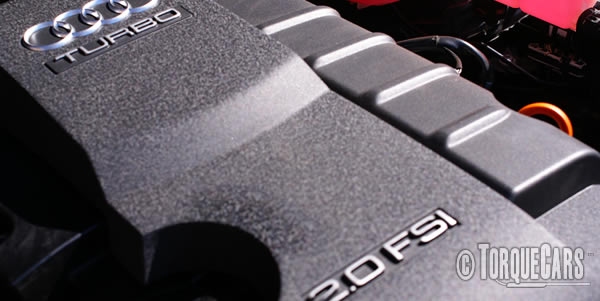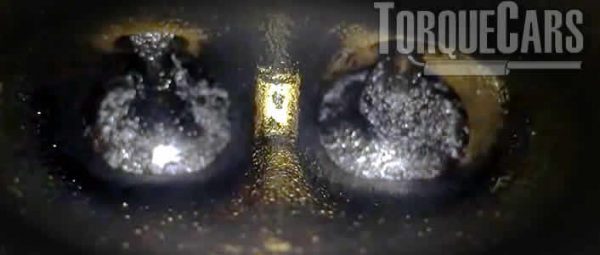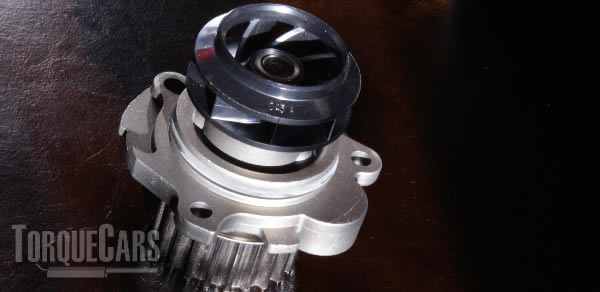Issues and common problems on the 2.0TFSi
"I will document all of the problems encountered with the 2.0TFSi engine"
These engines are superb, and the third generation was quite a different beast to the early ones with many revisions and updates, and most of them address these issues.
There are few engines that provide so much power and response and have such tuning potential but as with any highly engineered piece of hardware there will be weaker areas that need some attention and care.
Don't worry about these problems, just be informed that they are common so you can keep an eye out for them, and avoid them happening by keeping an eye on these potential weakspots in your engine.
Please watch our video which provides a good introduction to VW 1.8 & 2.0 TFSi problems. Be sure to keep up with our latest YouTube content and subscribe.
2.0TFSi common problems
- Excessive oil usage
- Turbo Pressure loss and hesitation (error codes)
- Wearing of the cam follower
- Carbon Accumulation and build up in the intake valves.
- Turbo control valve failures N75 & N249
- Water pump failures are common
There were 3 generations of the 2.0TFSi badged internally as the EA888
1st Gen
CAWA CBFA CAWB CCTB with a KKK K03 turbocharger delivering 8.75 PSI and regulated by Bosch Motronic MED 17.5 the CA— engines were Euro IV compliant, the CA— units were ULEV2 compliant, and the CCTA was constructed to comply with California SULEV standards with three lambda probe sensors.
2nd Gen
The Second Generation Released in 2008, AVS (2 stage valve lift control) was utilized on Audi engines, most notably the CCZA, CCZB, CCZC, and CCZD. The CDNC engine complies with Euro V regulations, whereas the CAEB unit complies with ULEV 2 standards.
3rd Gen
The Third Generation A significant redesign with an emphasis on efficiency and weight reduction. While the cylinder head design is entirely new, AVS was kept to control the intake valves.
To prevent carbon accumulation on the valves, a second intake injector was installed. We had IHI IS20 turbochargers and Garrett MGT 1752S turbochargers in select units (CULA CULV CULC CPLA CPPA) SIMOS version 18.1
These vehicles were equipped with a Seimens ECU, which aided in meeting Euro VI emissions rules. CJX denotes a performance engine with modified heat ports, improved injectors, and a fuel pump that can provide a greater return on your tuning effort or may be utilized to contribute performance items to your project.
For details on tuning these engines see our 2.0TFSi tuning guide.
Excessive oil usage & consumption
Although high oil consumption is generally anticipated with these engines, if you are topping off more than 1l every month, you have a problem that has to be addressed. If you are topping up with less than 1 liter per 1100 miles, you are within normal tolerances.
In general, excessive oil consumption is caused by crankshaft seals, and when retrofitted, a subsequent adjustment to the oil separator alleviates this problem.
Turbo Pressure loss and hesitation (error codes) N249 & N75 problems
N249 problems, are generally manifest as a fault code, but the N75 and N249 are often confused, as they are both connected to the turbo and perform similar(ish) tasks involving air control.
N249
The cut off valve is a solenoid that controls the recirculation and is installed on the turbo. These had a brittle diaphragm. The turbocharger air recirculation valve responds to a closed throttle by returning pressurized air to the intake; this assists in keeping the turbo spooling up, and lag is often a sign of this issue.
Fitting a BOV that vents to the atmosphere is a terrible idea since it will cause the engine to run rich and will likely activate the limp home mode.
N75
Only on the 1 Gen 2.0 TFsi is the N75 valve used to manage the boost pressure and this is prone to leak or break down, there are stronger drop in replacements around and if you've tuned your 2.0TFSi then this is a very good idea to sort before you get issues.
Excessive wear on the cam follower
The primary weak point is the cam follower placed underneath the mechanical high-pressure fuel pump. It features a low friction covering similar to "Teflon." The follower is shaped like a thimble and is located at the bottom of the fuel pump. Check for wear on this every couple years or around 30,000 miles.

This flaw was corrected in subsequent models by the use of a new cam lobe configuration; for example, the 220bhp BUL engines are not impacted by this issue.
You're looking for the coating to wear away; if it has and exposed a metal surface, this results in very rapid wear through the follower and destroys the cam shaft.
You'll first notice it when your fuel pump loses pressure and your check engine light illuminates. It is a straightforward examination that the majority of drivers are capable of doing.
Take extra caution with the very high fuel pump pressures and ensure that the pressure is removed from the system; a jet of gasoline at this pressure has the ability to cut through bone or cause significant harm!
Carbon Accumulation and build up in the intake valves.
The second often mentioned issue is carbon buildup on the valves as a result of direct injection.
Although this is a typical problem with engines of this sort, V6 and V8 engines are particularly susceptible owing to their lower RPM characteristics. Carbon buildup occurs as a result of gasoline not being injected across the valves, which would maintain them clean.

When the engine is cold, the unburned particles are reintroduced into the intake, where they clog it. Therefore, limiting short travels and ensuring the engine reaches operating temperature as early as possible would help avoid this problem.
After 70,000 miles, a decoke is advised; however, this recommendation is dependent on the kind of driving you undertake. Once a year, adding BG44K to the gasoline will maintain the engine, injectors, and exhaust clean, but will not clean the intake valves.
Carbon buildup is significantly decreased when the remainder of the engine is running properly.
The Intake clean process
A thorough BG intake clean conducted by an expert equipped with the proper tools will do an excellent job of regaining lost performance. If you are not achieving the power numbers you anticipate, you most likely have this problem.
This involves a cleaning solution being injected into the intake valves with a running engine and over the duration of this it will dissolve the accumulated carbon deposits.
Direct injection engines with a larger capacity are considerably more prone to carbon buildup difficulties.
Walnut blasting is another method which is quite effective, it required removal of the intake manifold though and is quite messy.
Routine care to slow the buildup of carbon
Carbon buildup will drain you of power rather than cause significant harm, but cleaning the head will significantly improve performance and efficiency. (Adding BG44K to my engine increased the average MPG on a comparable journey from 31.4 to 37 mpg. AND I AM NOT BEING COMPENSATED FOR SAYING THIS.
It demonstrates the extent to which the injectors in my 70,000-mile 220bhp TFSi engine were blocked.)
We have not seen proof that water/alcohol injection cleans the intake valves, with some water injection engine owners still experiencing carbon buildup (biofuels like alcohol are not recommended on FSI engines anyway).
Breather catch tanks are frequently recommended as a means of preventing this issue, although we have heard from owners who have these devices and are still experiencing carbon build up.
Preventing the accumulation of carbon
As the saying goes, prevention is preferable than cure, what can be done to avoid this carbon buildup issue?
When combined with a high-quality clean-burning gasoline that is devoid of bio components, the higher-octane fuels also tend to burn cleaner. Bring the engine up to operating temperature as quickly as possible (do not idle; just run it steadily at roughly 2000rpm until it warms up) and maintain the engine at 3000rpm for 15 minutes every week.
The engine is engineered to operate hotter at this RPM range, which helps burn off some of the carbon deposits.
Keep an eye on the recirculation valve; the oil that it sprays into the intake when it shuts off is noted as a key contributor to carbon buildup. If you detect excessive oil usage, get this valve inspected immediately. (TorqueCars defines excessive oil usage as the use of more than 1 litres per 1000 miles.)
We have seen some outstanding outcomes with intake cleaners that are sprayed into the intake at high pressure; these are not do-it-yourself sprays.
A camera probe inserted into the intake or spark plugs will indicate the level of carbon buildup, enabling you to make an educated decision as to whether you fix this or live with it for a bit longer.
The DIY spray cans of carbon cleaning do admirably well but probably only 50% as good as a professional clean; the secret is to equally distribute the cleaner to all of the valves; normally, the cylinders closest to the vacuum line benefit the most from these.
Remove the intake manifold for the greatest results and spray the cleaner directly into the problem region, allowing it to sink in. (Always adhere to the manufacturer's directions, since I'm sure certain formulas should be kept on for extended lengths of time.)
Driving the engine at just over 3000 RPM increases the temperature and puts the engine into "cleaning mode," where it runs leaner and hotter, clearing out most of the carbon build up within the engine, so aim to reach this sweet spot as often as possible and for at least 15 minutes every week.
Water pump failures are common
With age the splines in the water pump can break, TorqueCars strongly suggest that when you get the cambelt changed you also swap the water pump.

The above image shows the plastic splines on my new water pump, there are metal alternatives around that last "forever" but you should be fine just swapping in a new one with the cambelt change, the labor cost is insignificant as the belt is being removed anyway.
Symptoms of this problem include overheating or erratic temperature display on the thermostat, in my case, the needle just didn't move above a certain point and the engine started running hot.
Whilst you are looking at the cooling system check for leaks, the thermostat housing seems weaker on the 3rd Generation 2.0 TFSi engines.
There are a few problems and issues to look out for on other popular vag group engines, but I've split these off into other articles.
- 2.0 TFSi carbon buildup issues - direct injection engines require an intake clean.
- 2.0 TFSi problems - N75 and N249, high oil consumption, Cam Follower wear, Water Pump failure, and Turbo issues
- 2.0 TDi problems - Flywheel, Oil pump, Lumpy Idling
- 1.8T Problems - Diagnosing the common faults and issues
To discuss mods, upgrades and get assistance with any problems you've had with your 2.0TFSi engine please drop us a message in the forums or post a comment below if you'd like to pass on a tip or suggestion that will help me to improve this page for our readers.
Please Check out my YouTube channel, we're regularly adding new content...
PLEASE HELP: I NEED YOUR DONATIONS TO COVER THE COSTS OF RUNNING THIS SITE AND KEEP IT RUNNING. I do not charge you to access this website and it saves most TorqueCars readers $100's each year - but we are NON PROFIT and not even covering our costs. To keep us running PLEASE Donate here
If you liked this page please share it with your friends, drop a link to it in your favourite forum or use the bookmarking options to save it to your social media profile.
Feedback - What do You Think?
Please use our forums if you wish to ask a tuning question, and please note we do not sell parts or services, we are just an online magazine.
Help us improve, leave a suggestion or tip
Please watch this video and subscribe to my YouTube channel.

 Click to accept YouTube Cookies & Play.
Click to accept YouTube Cookies & Play.